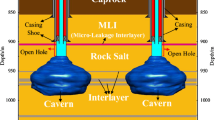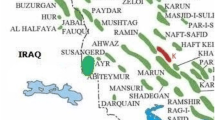Abstract
The wellbore tightness of a salt cavern gas storage must be tested before solution mining. According to the test results, it will be evaluated whether the wellbore can meet the cementing requirements of gas storage. However, there are many complex reasons that may cause wellbore leakage; hence, how to comprehensively analyze the test results and accurately expose the causes, locations, and scale of the leakage pose many challenges. These mainly include the incomplete test method and lack of theoretical analysis model. A nitrogen leak test was carried out for five wellbores that have been completed in Jintan (Jiangsu, China). The results show that two of them had leakage risk. To clarify the leakage causes and leakage types, we carried out an investigation of engineering geological data of the wellbores and further conducted laboratorial tests and theoretical analysis. The studies of drilling design and engineering geology show that the wellbores have good integrity and initially reveal that a mudstone interlayer intersecting the open hole between the casing shoe and the top of the salt cavern is a potential leaking layer. Furthermore, the permeability experiments and CT scans confirm that this mudstone interlayer is a leaking stratum and that the internal cracks develop severely. They are the key reasons leading to wellbore tightness failure. The proposed seepage theoretical model determines that the leakage type is horizontal flow in the mudstone interlayer. Comparing the theoretical results with the field test data, we find that the leakage rate curves of the two are in good agreement, which completely confirms that the mudstone interlayer is the fundamental cause of the wellbores tightness failure. This research not only identifies the leakage causes and leakage types of wellbores, but also enriches the leakage rate analysis method of gas storage and provides a theoretical and experimental analysis method for tightness evaluation of bedded salt cavern storage.











Similar content being viewed by others
Abbreviations
- \(p,\,{p_0},\,{p_{{\text{in}}}}\) :
-
The pressure in the mudstone interlayer, the initial pore pressure and injection pressure, respectively (Pa)
- \(r,\,{r_{\text{a}}},\,{r_{\text{d}}}\) :
-
The seepage range, the radius of the open hole and maximum leakage range, respectively (m)
- \(k\) :
-
The permeability of the mudstone interlayer (m2)
- \(\phi\) :
-
The porosity of the mudstone interlayer (1)
- \(t\) :
-
The seepage time (h)
- \(M\) :
-
The molar mass of the gas (g/mol)
- \(T,\,{T_0}\) :
-
The strata temperature and atmosphere temperature (K)
- \(R\) :
-
The universal gas constant (8.314 J/mol/K)
- \(m\) :
-
The leaking mass (kg)
- \(V\) :
-
The leaking volume (m3)
- \(Q\) :
-
The leakage rate determined by the theoretical analysis (m3/h)
- \(\bar {Q}\) :
-
The average leakage rate observed by the field test (m3/h)
- \(h\) :
-
The any depth along the wellbore (m)
- \(n\) :
-
The average thickness of the leaking layer (m)
- \({p_{\text{h}}},\,{p_{\text{s}}},\,{p_{\text{w}}}\) :
-
The pressure at any depth in the wellbore, the standard atmosphere pressure and wellhead pressure (Pa)
- \({T_{\text{h}}}\) :
-
The temperature at any depth in the wellbore (K)
- \(A\) :
-
The horizontal cross-sectional area of the wellbore (m2)
- \(\lambda\) :
-
The distance of slice to the top of the sample (mm)
References
Allison ML (2001) Hutchinson, Kansas: a geologic detective story. Geotimes 46(10):14–19
API (1994) Recommended practice for the design of solution-mined underground storage facilities. API 1114 ED. 1. American Petroleum Institute, Washington D.C.
Association CS (2002) Storage of hydrocarbons in underground formations. Canadian Standards Association, Mississauga
Bear J, Bachmat Y (2012) Introduction to modeling of transport phenomena in porous media, vol 4. Kluwer Academic Publishers, Dordrecht
Benge G (2009) Improving wellbore seal integrity in CO2 injection wells. Energy Procedia 1(1):3523–3529
Bérest P, Brouard B (2003) Safety of salt caverns used for underground storage blow out; mechanical instability; seepage; cavern abandonment. Oil Gas Sci Technol 58(3):361–384
Bérest P, Brouard B, Durup JG (2001) Tightness tests in salt-cavern wells. Oil Gas Sci Technol 56(5):451–469
Boulin PF, Bretonnier P, Vassil V, Samouillet A, Fleury M et al (2013) Sealing efficiency of caprocks: experimental investigation of entry pressure measurement methods. Mar Pet Geol 48(48):20–30
Bracke G, Fischer-Appelt K (2015) Methodological approach to a safety analysis of radioactive waste disposal in rock salt: an example. Prog Nucl Energy 84:79–88
Cornet JS, Dabrowski M, Schmid DW (2018) Long term creep closure of salt cavities. Int J Rock Mech Min Sci 103:96–106
Cosenza P, Ghoreychi M, Bazargan-Sabet B, Marsily GD (1999) In situ rock salt permeability measurement for long term safety assessment of storage. Int J Rock Mech Min Sci 36(4):509–526
Crotogino F (1995) SMRI reference for external well mechanical integrity testing/performance, data evaluation and assessment. Summary of the final project report, SMRI: 95-0001
De Simone M, Pereira FL, Roehl DM (2017) Analytical methodology for wellbore integrity assessment considering casing-cement-formation interaction. Int J Rock Mech Min Sci 94:112–122
Diamond H (1989) The water-brine interface method, an alternative mechanical integrity test for salt solution mining wells. In: Proceedings of SMRI fall meeting, San Antonio
Diamond H, Bertram B, French P, Petrick G, Schumacher M et al (1993) Detecting very small casing leaks using the water-brine interface method. In: Proceedings of seventh symposium on salt, Amsterdam, pp 363–368
El Tani M (2012) Grouting rock fractures with cement grout. Rock Mech Rock Eng 45(4):547–561
EN (1998) Gas supply systems-underground gas storage—Part 4: Functional recommendations for storage in rock caverns. CEN EN 1918-4-1998
Fransson Å, Tsang C-F, Rutqvist J, Gustafson G (2007) A new parameter to assess hydromechanical effects in single-hole hydraulic testing and grouting. Int J Rock Mech Min Sci 44(7):1011–1021
Genedy M, Kandil UF, Matteo EN, Stormont J, Taha MMR (2017) A new polymer nanocomposite repair material for restoring wellbore seal integrity. Int J Greenh Gas Control 58:290–298
Gray KE, Podnos E, Becker E (2007) Finite element studies of near-wellbore region during cementing operations: Part I. SPE Drill Complet 24(1):127–136
Heath JE, Dewers TA, Mcpherson BJOL, Nemer MB, Kotula PG (2012) Pore-lining phases and capillary breakthrough pressure of mudstone caprocks: sealing efficiency of geologic CO2 storage sites. Int J Greenh Gas Control 11(6):204–220
Istvan JA, Evans LJ, Weber JH, Devine C (1997) Rock mechanics for gas storage in bedded salt caverns. Int J Rock Mech Min Sci 34(3–4):647–647
Jing WJ, Yang CH, Chen F (2011) Risk assessment of salt cavern oil/gas storage based on accident statistical analysis. Rock Soil Mech 32(6):1787–1793
Kang H, Feng Z (2013) Status and development tendency of roadway grouting reinforcement technology in coal mine. Coal Min Technol 18(3):1–7
Kiran R, Teodoriu C, Dadmohammadi Y, Nygaard R, Wood D et al (2017) Identification and evaluation of well integrity and causes of failure of well integrity barriers (a review). J Nat Gas Sci Eng 45:511–526
Kuijk RV, Zeroug S, Froelich B, Allouche M, Bose S et al (2005) A novel ultrasonic cased-hole imager for enhanced cement evaluation. In: International petroleum technology conference
Li Y, Liu W, Yang C, Daemen JJ (2014) Experimental investigation of mechanical behavior of bedded rock salt containing inclined interlayer. Int J Rock Mech Min Sci 69:39–49
Liu W, Chen J, Jiang D, Shi X, Li Y et al (2016) Tightness and suitability evaluation of abandoned salt caverns served as hydrocarbon energies storage under adverse geological conditions (AGC). Appl Energy 178:703–720
Remizov VV, Pozdnyakov AG, Igoshin AI (2000) Examination of rock salt underground cavern testing for leak-tightness by pressure alteration. In: SMRI fall meeting, San Antonio, Texas, USA, pp 55–64
Schulze O, Popp T, Kern H (2001) Development of damage and permeability in deforming rock salt. Eng Geol 61(2–3):163–180
Schwind BE, Payne ML, Otten GK, Prideco G, Pattillo PD (2001) Development of leak resistance in industry standard OCTG connections using finite element analysis and full scale testing. In: SPIE medical imaging, pp 317–323
Ślizowski K, Janeczek J, Przewłocki K (2003) Suitability of salt-mudstones as a host rock in salt domes for radioactive-waste storage. Appl Energy 75(1–2):119–128
Sovacool BK (2008) The costs of failure: a preliminary assessment of major energy accidents, 1907–2007. Energy Policy 36(5):1802–1820
Thiel W (1993) Precision methods for testing the integrity of solution mined underground storage caverns. In: Proceedings of 7th symposium on salt, Elsevier Science Publisher, Amsterdam, pp 377–383
Uchikawa H (1994) Ultra-fine cements for special applications. Adv Cem Based Mater 1(3):150–154
Wang T, Ma H, Yang C, Shi X, Daemen JJK (2015) Gas seepage around bedded salt cavern gas storage. J Nat Gas Sci Eng 26:61–71
Warren JK (2017) Salt usually seals, but sometimes leaks: implications for mine and cavern stabilities in the short and long term. Earth Sci Rev 165:302–341
Wu YS, Pruess K, Persoff P (1998) Gas flow in porous media with Klinkenberg effects. Transp Porous Media 32(1):117–137
Yang C, Jing W, Daemen JJK, Zhang G, Du C (2013) Analysis of major risks associated with hydrocarbon storage caverns in bedded salt rock. Reliab Eng Syst Saf 113(1):94–111
Yuan G, Shen R, Yuan J, Tian Z, Lu L et al (2007) Study and application of tightness testing technology for salt cavern gas storage. Acta Petrolei Sinica 28(4):119–121
Zhang Q, Peng LI, Xiao Z, Shucai LI, Zhang W et al (2015) Model test of grouting strengthening mechanism for fault gouge of tunnel. Chin J Rock Mech Eng 34(5):924–934
Acknowledgements
The authors would gratefully like to acknowledge the financial support from the National Natural Science Foundation of China (nos. 41472285, 51774266, 51404241, 51604044), which is greatly appreciated. Many thanks to Jaak J. Daemen for English help.
Author information
Authors and Affiliations
Corresponding authors
Additional information
Publisher’s Note
Springer Nature remains neutral with regard to jurisdictional claims in published maps and institutional affiliations.
Rights and permissions
About this article
Cite this article
Chen, X., Li, Y., Liu, W. et al. Study on Sealing Failure of Wellbore in Bedded Salt Cavern Gas Storage. Rock Mech Rock Eng 52, 215–228 (2019). https://doi.org/10.1007/s00603-018-1571-5
Received:
Accepted:
Published:
Issue Date:
DOI: https://doi.org/10.1007/s00603-018-1571-5




